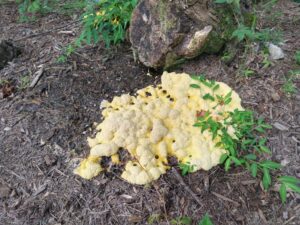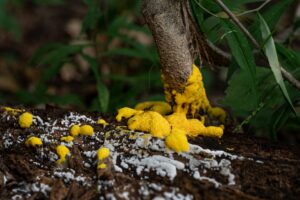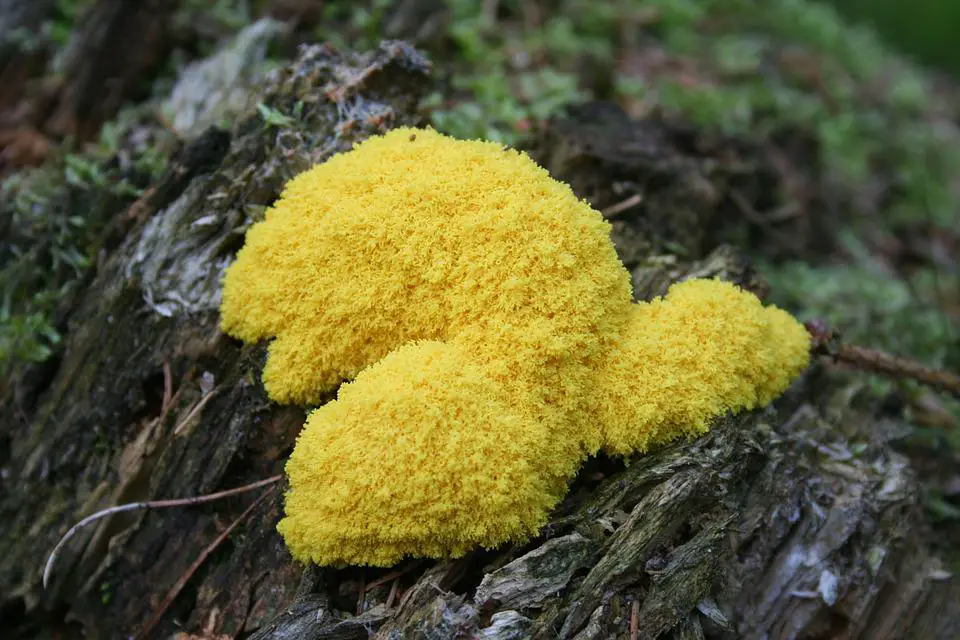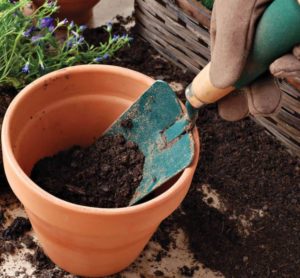The first time I saw Fuligo septica, I thought an animal had vomited in my backyard. I was not surprised, therefore, when I later discovered that the organism is also known as dog vomit slime mold, an appropriate name to be sure. Others call it scrambled egg slime mold because its color sometimes resembles the breakfast favorite. More research into this strange organism revealed that in Scandinavian folklore, it is known as the vomit of troll cats,[1] while in Latvia, the primitive organism is referred to as witches’ butter or witches’ spit.[2]
Once you realize that the bright yellow to white substance is not what it first appears to be, your second impression is that it must be some type of fungus. However, dog vomit slime mold is not a fungus. In fact, it is not even a mold. Rather, it is a plastid, and it behaves more like an amoeba than anything else. It begins as a single-cell organism but then it joins ranks with other single-cell organisms to create a plasmodium.

This article contains affiliate links. If you make a purchase using one of these links, I will receive a very small commission at no additional cost to you, and it will help me maintain this website. Rest assured, I only recommend products I actually like!
Where Does Fuligo septica Come From?
Dog vomit slime mold spores are easily spread via the wind. They prefer warm, moist, shady conditions but can also grow in sunnier areas. They remain viable for years as they wait for the right conditions to proliferate.
Dog vomit slime mold is saprophytic, meaning it feeds on decaying organic matter. Thus, if you come across it, you can be sure it has found a source to support its growth. Common hospitable environments include mulch in garden or flower beds, as well as, compost piles, untreated lumber, decaying limbs and logs, leaf litter, and lawns. Once the inactive spores absorb moisture, they will expand to form a spherical shape or swarm sphere, seemingly overnight. The slime mold typically grows to a height of a one to two inches and several inches wide.
There are more than 700 varieties of slime mold found all over the world.
Is Dog Vomit Slime Mold Good or Bad?
In general, the only problem with dog vomit slime mold is that it looks unappealing. It is not known to harm plants. On the contrary, it is beneficial to the environment because it aids in breaking down organic matter. What’s more, it can turn heavy metals found in soil into their inactive form. Of course, most importantly, it is not considered harmful to pets or humans, although it has been known to trigger allergic rhinitis and asthma in those who are susceptible.[3],[4]
How to Get Rid of Slime Mold
Even though it is not harmful to the environment, some still prefer to do remove it from their yard or garden. Keep in mind, however, that regardless of the removal method, some spores will be released when the mound is touched. Nevertheless, if you need to remove it, you can try one of the following methods.

1. Do not spray the slime mold with water, as this only serve to spread the spores. Instead, let the area dry out by reducing or temporarily halting irrigation to the area.
2. Use a shovel or spade to scoop the slime mold and the top layer of mulch or other material it is feeding on. Do not place it in the compost pile since most piles do not reach high enough temperatures to kill the spores. Instead, bag it up, tie up the bag, and throw it in the garbage can.
3. If the slime mold is growing on the sides of untreated lumber or on branches, stumps, or logs, use a hand trowel to scrape it off. Dispose of it in the same manner as above.
Be sure to clean shovel, hand trowels, and any other tools you use in the removal process to keep from transferring spores. You can learn more about how to properly disinfect tools in this helpful article.
4. If you find that the slime mold is recurring in a shaded area despite previous efforts to eliminate it, you may want to consider trimming overhead or nearby tree branches to allow more sunlight into the area. This will help dry out the space and make it less hospitable to spores.
While dog vomit slime mold is rather unsightly, it is generally not problematic and will dissipate on its own, usually within a few days, especially if moisture is decreased.
Thank you for reading this article! If you found it helpful, please consider sharing it with others via email and social media!
[1] Kvideland, Reimund; Sehmsdorf, Henning K. (1988). “39. Troll Cat”. Scandinavian Folk Belief and Legend. Minneapolis: U of Minnesota P. pp. 175–79.
[2] Fuligo septica, Wikipedia, accessed 08-14-22, https://en.wikipedia.org/wiki/Fuligo_septica
[3] Santili J, Rockwell WJ, Collins RP (1895). “The significance of the spore of the Basidiomycetes (mushrooms and their allies) in bronchial asthma and allergenic rhinitis”. Annals of Allergy. 55 (3): 469–71.
[4] Gianini EH, Northy WT, Leathers CR (1975). “The allergenic significance of certain fungi rarely reported as allergens”. Annals of Allergy. 35 (6): 372–6.



